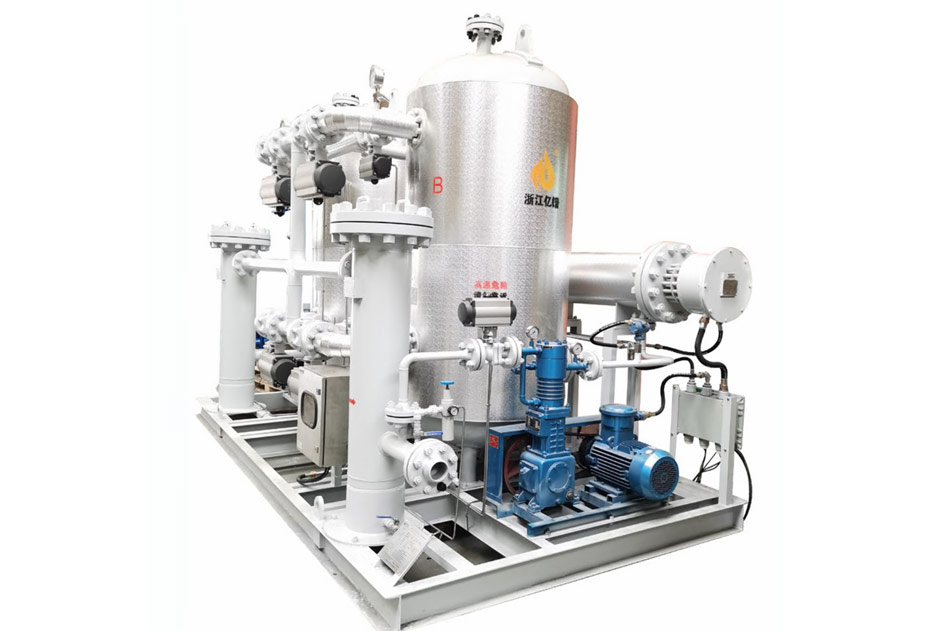Methane-Hydrogen Mixture Purification for Hydrogen Production
Industry Pain Points
- Single Hydrogen Source: Currently, industrial hydrogen mainly relies on fossil fuel reforming (e.g., natural gas steam reforming) or water electrolysis for hydrogen production. The former has high carbon emissions, while the latter is costly.
- Difficulty in Impurity Separation: Methane-hydrogen mixed gases (e.g., coke oven gas, biomass gas, or natural gas mixtures) contain impurities such as CH₄, CO₂, CO, and H₂S besides hydrogen. Traditional Pressure Swing Adsorption (PSA) or membrane separation technologies have low efficiency and high energy consumption.
- Cost Pressure: Existing purification technologies (e.g., cryogenic separation) require large equipment investment and high operating costs, which are difficult for small and medium-sized enterprises to bear.
- Environmental Requirements: Traditional processes have high carbon emissions and cannot meet the demand for green hydrogen under the “dual carbon” goals.
SYSTEM OVERVIEW
Yipu’s Methane-Hydrogen Mixture Hydrogen Purification Solution adopts “catalytic cracking + multi-stage adsorption” technology to efficiently separate hydrogen from industrial by-product gases and natural gas, achieving a purity of 99.999%. Compared with traditional PSA, its energy consumption is reduced by 30%, recovery rate exceeds 90%, unit cost is reduced by 15%, and carbon footprint is <1kg CO₂e/kg H₂. The modular design is suitable for distributed scenarios, and it produces high-value carbon materials with an investment payback period of 3-4 years. It is applicable to chemical industry, transportation, energy storage and other fields, and promotes the large-scale application of green hydrogen with the advantages of low cost and low carbon emissions.
Solution Approach
Yipu Methane-Hydrogen Mixture (Natural Gas) Hydrogen Purification Solution
| Module | Technical Solution | Performance Indicators |
|---|---|---|
| Feed Gas Type | Coke oven gas / biomass gas / natural gas-hydrogen mixture | H₂ content ≥30%, CH₄ 20-60%, CO₂ 5-20%, with trace sulfides |
| Pre-Treatment System | Two-stage desulfurization (dry + wet) → particle filtration → heating and pressure regulation | Sulfur content <0.1ppm, particles <1μm, operating pressure 1.0-3.0MPa |
| Core Process | Catalytic cracking (Ni-Fe/Al₂O₃ catalyst) → water-gas shift → two-stage PSA adsorption | Methane conversion rate >95%, CO conversion rate >98%, PSA adsorption cycle ≤8min |
| Hydrogen Output | 99.999% high-purity hydrogen → buffer tank → compressor | Dew point < -70℃, CO <0.1ppm, total impurities <10ppm |
| By-Product Treatment | Solid carbon (purity >98%) → collection system; CO₂ (purity >99%) → liquefaction device | Carbon yield 0.3kg/Nm³ CH₄, CO₂ capture rate >90% |
| Energy Efficiency | Intelligent frequency conversion control + waste heat recovery system | Comprehensive energy consumption 0.9-1.1kWh/Nm³ H₂, thermal efficiency >85% |
| Equipment Specification | Modular design (standard unit: 5000Nm³/h) | Floor area <200㎡/unit, noise <75dB, automation rate >95% |
| Environmental Indicators | Carbon footprint accounting + online monitoring | Life-cycle carbon emissions <1.0kg CO₂e/kg H₂, no wastewater discharge |
| Economy | Investment cost: 12,000-18,000 RMB/Nm³·h | Operating cost <0.8 RMB/Nm³ H₂, investment payback period 3-4 years (based on hydrogen price 25 RMB/kg) |
Notes:
- Data is based on feed gas with 40% hydrogen content;
- Equipment service life >15 years (catalyst replacement every 5 years);
- Adaptable to ambient temperature: -30℃~50℃
Technical Principles
Yipu adopts “high-efficiency catalytic conversion + multi-stage adsorption coupling” technology, with the core steps as follows:
- Pre-Treatment Stage:Remove H₂S, organic sulfur, and trace CO through desulfurizers (e.g., ZnO) and iron oxide adsorption.
- Catalytic Conversion Stage:
- Catalytic cracking of methane: CH₄ → C (solid carbon) + 2H₂ (no CO₂ emission).
- Water-Gas Shift (WGS) reaction: CO + H₂O → CO₂ + H₂, improving hydrogen yield.
- Multi-Stage Adsorption Purification:
- Primary PSA: Remove CO₂ and residual CH₄.
- Secondary molecular sieve adsorption: Deeply remove trace CO (<1 ppm) to meet the hydrogen standard for fuel cells (ISO 14687).
CORE ADVANTAGE
| Advantage Category | Description |
|---|---|
| Customized on Demand | Meets special working conditions; provides professional non-standard customization |
| Low Cost | Adopts cyclic regeneration process; significantly reduces usage costs |
| High Stability | Double-tower structure with small pressure fluctuation; low noise and continuous gas supply |
| Fully Automatic Operation | Easy to operate, reducing labor input; improves efficiency |
| High Safety | Presets multi-level safety protection measures; supports automatic alarm |
| Low Failure Rate | Maintains low failure rate after 10,000 hours of operation; nearly maintenance-free durability |
TECHNICAL STRENGTH
Leading Adsorption Dehydration Technology
- Uses high-performance molecular sieve adsorbents with high water absorption capacity and resistance to acidic gas (H₂S/CO₂) corrosion, ensuring deep dehydration with a dew point ≤ -70℃.
- Features an original hot nitrogen regeneration process, reducing energy consumption by 30% compared to traditional electric heating regeneration, and integrates a waste heat recovery system to significantly improve energy efficiency.
Modular and Customized Design Capability
- Core equipment adopts modular prefabrication, supporting rapid deployment (installation cycle shortened by 50%) and adapting to diverse scenarios such as offshore platforms, onshore gas fields, and LNG pre-treatment.
- Can customize single-tower, double-tower, or multi-tower parallel systems according to customer needs, with a treatment capacity ranging from 10,000 to 1,000,000 Nm³/d, flexibly matching gas fields of different scales.
Intelligent Control and Remote Operation & Maintenance
- Equipped with a PLC+IoT intelligent control system to monitor key parameters such as pressure, temperature, and dew point in real time, supporting fault early warning and automatic adjustment.
- Optimizes the adsorption-regeneration cycle through cloud-based big data analysis, extending the service life of molecular sieves and reducing operation and maintenance costs by 10%-15%.
Energy-Saving and Environmental Protection Technology
- Features zero-emission design for regenerated tail gas, complying with EU CE, US EPA, and other international environmental standards.
- Energy consumption is 25%-40% lower than that of traditional Triethylene Glycol (TEG) dehydration systems, helping customers achieve carbon emission reduction goals.
Long-Cycle Operation Reliability
- Molecular sieves adopt anti-pulverization coating technology, with a service life of over 5 years, reducing replacement frequency.
- Key components (such as valves and instruments) are selected from international first-tier brands (e.g., Siemens, Emerson), with a Mean Time Between Failures (MTBF) of over 100,000 hours.
Strong R&D and Engineering Experience
- Holds 19+ patents for dehydration technology and software copyrights; the R&D team is led by doctors and maintains in-depth cooperation with universities and colleges.
- Has over 1,000 successful cases worldwide, covering extreme working conditions such as high-sulfur gas fields in the Middle East and low-temperature environments in the Arctic.
Product Advantage Comparison
| Indicator | Yipu Solution | Traditional PSA | Water Electrolysis for Hydrogen Production |
|---|---|---|---|
| Hydrogen Purity | ≥99.999% | 99.9%~99.99% | 99.999% |
| Energy Consumption (kWh/Nm³ H₂) | 0.8~1.2 | 1.5~2.0 | 4.5~5.5 |
| Carbon Footprint (kg CO₂e/kg H₂) | 0.5~1.0 | 8~10 (natural gas reforming) | 0 (green electricity) |
| Investment Payback Period | 3~4 years | 5~7 years | 8~10 years |
| Applicable Scenarios | Industrial by-product gas, natural gas | Large chemical plants | Renewable energy-rich areas |
Typical Case
Project Name: A Coking Industrial Park
Working Conditions
- Feed Gas Source: Coke oven gas (containing 55% H₂, 25% CH₄, 6% CO, 10% CO₂, 3% N₂, 200ppm H₂S)
Results
- Treatment Scale: 0,000 Nm³/h coke oven gas → 5,500 Nm³/h high-purity hydrogen
Economic Benefits
- High Added Value: Annual revenue from by-product carbon materials exceeds 3 million RMB (based on 2,000 RMB/ton)
- Low-Carbon Certification: Carbon footprint per kilogram of hydrogen is only 0.8kg CO₂e, eligible for green hydrogen subsidies

